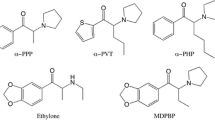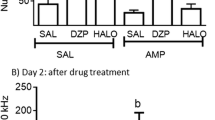Abstract
The effects of β-phenylethylamine (PEA 6.25, 12.5, and 25.0 mg/kg IP) on spontaneous motor activity were examined in rats before (novel situation) and after (familiar situation) they had experience of the test environment, in an undrugged state. In a novel cage, 12.5 mg/kg PEA stimulated rearing and locomotion. A dose of 25.0 mg/kg PEA also increased rearing and produced stereotyped head movements, but did not increase locomotion, in a novel environment. In a familiar cage, both 12.5 and 25.0 mg/kg PEA stimulated locomotion and sniffing, whereas rearing was unaffected by PEA treatment under these conditions. These data provide a striking instance of a qualitative change in the behavioural response to a psychostimulant compound which is associated with the relative familiarity of the animal with the test environment. In addition, the results show that PEA induces stereotypy at high doses and increases locomotor activity at moderate doses, which is a further illustration of the similarity in the unconditioned behavioural effects of PEA and amphetamine.
Similar content being viewed by others
References
Archer J (1973) Tests for emotionality in rats and mice: a review. Anim Behav 21:205–235
Borison RL, Havdala HS, Diamond BI (1977) Chronic phenylethylamine stereotypy in rats: a new animal model of schizophrenia? Life Sci 21:117–122
Borison RL, Mosnaim AD, Sabelli HC (1975) Brain 2 — phenylethylamine as a major mediator for the central actions of amphetamine and methylphenidate. Life Sci 17:1331–1343
Boulton AA, Juorio AV (1982) Brain trace amines. In: Lajtha A (ed) Handbook of neurochemistry, vol 1, 2nd ed. Plenum Press, New York, pp 189–222
Cooper SJ, Dourish CT (1984) Hypodipsia, stereotypy and hyperactivity induced by β-phenylethylamine in the water deprived rat. Pharmacol Biochem Behav 20:1–7
Dourish CT (1982) A pharmacological analysis of the hyperactivity syndrome induced by β-phenylethylamine in the mouse. Br J Pharmacol 77:129–139
Dourish CT (1983) Behavioural stimulant effect of a small dose of β-phenylethylamine following specific inhibition of type B monoamine oxidase. Soc Neurosci (Abstr) 9:P131
Dourish CT (1984) Studies on the mechanism of action of β-phenylethylamine stereotypy in rodents: implications for a β-phenylethylamine animal model of schizophrenia. In: Boulton AA, Baker GB, Dewhurst WG, Sandler M (eds) Neurobiology of the trace amines. Humana Press, Clifton, New Jersey, pp 389–411
Dourish CT, Bouton AA (1981) The effects of acute and chronic administration of β-phenylethylamine on food intake and body weight in rats. Prog Neuropsychopharmacol 5:411–414
Dourish CT, Dewar KM, Dyck LE, Boulton AA (1983a) Potentiation of the behavioural effects of the antidepressant phenelzine by deuterium substitution. Psychopharmacology 81:122–125
Dourish CT, Greenshaw AJ, Boulton AA (1983b) Deuterium substitution enhances the effects of β-phenylethylamine on spontaneous motor activity in the rat. Pharmacol Biochem Behav 19:471–475
Durden DA, Philips SR (1980) Kinetic measurements of the turnover rates of phenylethylamine and tryptamine in vivo in the rat brain. J Neurochem 34:1725–1732
Einon DF, Sahakian BJ (1979) Environmentally induced differences in susceptibility of rats to CNS stimulants and CNS depressants: evidence against a unitary explanation. Psychopharmacology 61:299–307
File SE, Wardill AG (1975) Validity of head-dipping as a measure of exploration in a modified holeboard. Psychopharmacologia 44:53–59
Fuxe K, Grobecker H, Jonsson J (1967) Effect of β-phenylethylamine on central and peripheral monoamine-containing neurons. Eur J Pharmacol 2:202–207
Gispen WH, Isaacson RL (1981) ACTH-induced excessive grooming in the rat. Pharmacol Ther 12:209–246
Greenshaw AJ, Dourish CT (1984) Differential aversive stimulus properties of β-phenylethylamine and of d-amphetamine. Psychopharmacology 82:189–193
Ho BT (1978) Behavioural effects of phenylethylamine: neurochemical correlates. In: Mosnaim AD, Wolf ME (eds) Noncatecholic phenylethylamines, part 1, phenylethylamine: biological mechanisms and clinical aspects. Marcel Dekker, New York, pp 271–287
Jackson DM (1978) β-phenylethylamine: studies on the mechanism of its stimulant effects. In: Mosnaim AD, Wolf ME (eds) Noncatecholic phenylethylamines, part 1, phenylethylamine: biological mechanisms and clinical aspects. Marcel Dekker, New York, pp 289–313
Mantegazza P, Riva M (1963) Amphetamine-like activity of β-phenylethylamine after a monoamine oxidase inhibitor in vivo. J Pharm Pharmacol 15:472–478
Mumford L, Teixeira AR, Kumar R (1979) Sources of variation in locomotor activity and stereotypy in rats treated with d-amphetamine. Psychopharmacology 62:241–245
Robbins TW, Sahakian BJ (1981) Behavioural and neurochemical determinants of drug-induced stereotypy. In: Rose FC (ed) Metabolic disorders of the nervous system. Pitman, London, pp 244–291
Sabelli HC, Vazquez AJ, Flavin D (1975) Behavioural and electrophysiological effects of phenylethanolamine and 2-phenylethylamine. Psychopharmacologia 42:117–125
Sahakian BJ, Robbins TW (1975) The effects of test environment and rearing condition on amphetamine induced stereotypy in the guinea pig. Psychopharmacologia 42:115–117
Sandler M, Reynolds GP (1976) Does phenylethylamine cause schizophrenia? Lancet 1:70–71
Scheel-Kruger J, Braestrup C, Nielsen M, Golembiowska K, Mogilnicka E (1977) Cocaine: discussion on the role of dopamine in the biochemical mechanism of action. In: Ellinwood EH, Kilbey MM (eds) Cocaine and other stimulants. Plenum Press, New York, pp 373–407
Siegel S (1956) Non-parametric statistics for the behavioural sciences. McGraw-Hill, New York
Stein L (1964) Self stimulation of the brain and the central stimulation action of amphetamine. Fed Proc 23:836–850
Welker WI (1957) “Free” versus “forced” exploration of a novel situation by rats. Psychol Rep 3:95–108
Winer BJ (1971) Statistical principles in experimental design. McGraw-Hill, New York
Wu PH, Boulton AA (1975) Metabolism, distribution and disappearance of injected β-phenylethylamine in the rat. Can J Biochem 53:42–50
Wyatt RJ (1978) Is there an endogenous amphetamine? a testable hypothesis of schizophrenia. In: Wynn LC, Cromwell RL, Matthysse S (eds) The nature of schizophrenia, Wiley, New York, pp 116–125
Yang HYT, Neff NH (1973) β-phenylethylamine, a specific substrate for type B monoamine oxidase of the brain. J Pharmacol Exp Ther 187:365–371
Author information
Authors and Affiliations
Rights and permissions
About this article
Cite this article
Dourish, C.T., Cooper, S.J. Environmental experience produces qualitative changes in the stimulant effects of β-phenylethylamine in rats. Psychopharmacology 84, 132–135 (1984). https://doi.org/10.1007/BF00432042
Received:
Accepted:
Issue Date:
DOI: https://doi.org/10.1007/BF00432042




